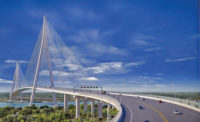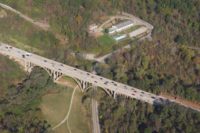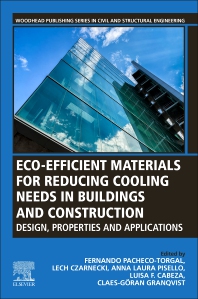

The 6th Street Viaduct Bridge in Los Angeles—the site of numerous Hollywood movie scenes—has reached the end of its career. Los Angeles city engineers are internally reviewing the Request for Proposals document for a final design to replace the structure, which consists of two prestressed concrete viaducts and a double steel arch center span, with a cable-stayed structure.
The Los Angeles City Council voted late last year to replace the 3,500-ft-long, 46-ft-wide viaduct in Boyle Heights, just east of downtown. The viaduct extends east-west across the Los Angeles River, Union Pacific Railroad and Metrolink tracks, US 101, and several local streets. Listed on the California Register of Historic Resources, the bridge’s concrete components have the equivalent of cancer.
“The bridge is very sick,” says Tonya Durrell, spokesperson for the Dept. of Public Works, City of Los Angeles. “It has Alkali-Silica Reaction (ASR) in its concrete. It is like a cancer, it is ongoing and irreversible. It just has to be demolished and another bridge built."
ASR is a well-known potential weakness in concrete structures. The chemical process is basically an attacking and breaking down of the silica in the aggregate which creates a gel. The gel then takes on water and expands. The gel is like a sponge and expands and can be seen oozing out of areas of the concrete that are stained. The concrete then begins to crack from the pressure of the expanding gel. Visible signs of the gel and the cracking can be seen throughout the bridge.
The 6th Street Viaduct Bridge is the only one of the many bridges over the L.A. River to have the fatal condition. Ironically, it was built with innovative concrete techniques for its time. A concrete plant was constructed on-site to produce the material for the bridge. “We now know how to proportion the concrete mixture so you don’t get ASR,” says Rachel Detwiler, an engineer and editor-in-chief of the Precast Prestressed Concrete Institute (PCI) Journal, “And you can choose different materials as long as you have a favorable chemistry. But at the time that the bridge was built, they did not know about Alkali-Silica Reaction.”
But being aware of the problem has not eliminated it. ASR has derailed even more contemporary projects. For example, in 1999, a 440-lb slab of concrete tunnel smashed onto the roof of a speeding Shinkansen bullet train in Japan due to weakening from ASR.
In 2004, seismic vulnerability studies determined that given the current rate of deterioration, the bridge has a 70% possibility of collapse over the next 50 years in a significant seismic event. This is in contrast to the accepted collapse probability of 5% or less over 50 years.
The city is carefully monitoring the bridge, which is still open to traffic, says John Koo, city bridge improvement project manager. He adds that the RFP for final design will be released "in the near future." The $401-million, mostly federally funded replacement bridge will start to take shape in three years after the design gets finalized with the ideas and approval of its aesthetically sensitive L.A. community. Once construction begins, the new bridge will be completed in about four years and will include modern amenities like wider sidewalks with room for pedestrians and cyclists.
The bridge, built in 1931 and featured in movies like "Grease" and "Terminator 2" is no stranger to bad news. Since just after it opened it has been plagued with material failures. Two pylons were removed in the 1940s because of the compromised condition of the concrete. In the 1980s, in an effort to shore up the bridge, its deck was stripped and its concrete sealed with a waterproof coating. And more recently, epoxy injections patches were administered to prevent moisture incursions, has left stains, according to 2007 official documents of the 6th Street Viaduct Seismic Improvement Project.





